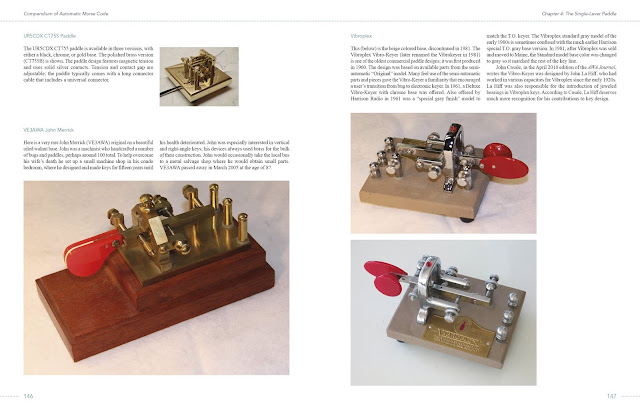Posts Tagged ‘Morse Code’
 Radio Virgin: the First QSO
Radio Virgin: the First QSO
My first QSO (and, yeah, it was with Morse code) was petrifying and…
What’s your story of your first QSO?
73 de NW7US
 Update: Propagation Forecasts for CQ WW (SSB and CW) DX Contest Weekends
Update: Propagation Forecasts for CQ WW (SSB and CW) DX Contest Weekends
Are you participating in this year’s CQ World-Wide DX Contest, either the SSB weekend (this coming weekend, October 28-29, 2017), or the CW weekend (November 25-26, 2017)? The CQ WW is the largest Amateur Radio competition in the world. Over 35,000 participants take to the airwaves on the last weekend of October (SSB) and November (CW) with the goal of making as many contacts with as many different DXCC entities and CQ Zones as possible.
I have updated my forecast on the expected propagation conditions during both the SSB and CW weekends of the 2017 CQ World-Wide DX Contest. I will publish a new update for the CW weekend, when we get closer to that November weekend.
The link to the latest update is: http://cqnewsroom.blogspot.com/2017/10/cqww-dx-contest-propagation-update.html
Good luck!
73 de NW7US dit dit
 Old, But Still Useful!
Old, But Still Useful!
This old WWII military training video is still useful regarding Morse code:
This is an antique United States Navy Training Film from 1943/1944, in which proper hand-sending of Morse code is demonstrated. The film covers some basic principles and mechanics of manual keying of the International Morse code, as used during WWII.
Amateur (Ham) radio operators find Morse code (and the ‘CW’ mode, or ‘Continuous Wave’ keying mode) very useful, even though Morse code is no longer required as part of the licensing process. Morse code is highly effective in weak-signal radio work. And, preppers love Morse code because it is the most efficient way to communicate when there is a major disaster that could wipe out the communications infrastructure.
While this military film is antique, the vintage information is timeless, as the material is applicable to Morse code, even today.
There’s more about Morse code, at my website: http://cw.hfradio.org
For additional joy, here are a few of old films regarding Morse code:
Morse Code – Principles and Basic Techniques (US Army Signal)
(Learn to Send Perfect Morse Code by Hand – Vintage Training Film (Ham Radio / CW))
Vintage 1944 Radio Operator Training: How to Send Morse Code (CW) by Hand
This one is a pretty cool film:
1939 Film: New Zealand Shortwave Communications; Morse code (CW)
I’ve also created a play list, and most of the videos are still online. Once and a while something changes and I have to update the list. Here is the list:
Original Title: TECHNIQUE OF HAND SENDING, by Department of Defense, Published 1944
Usage CC0 1.0 Universal
TECHNIQUE OF HAND SENDING
PIN 23735 1944
IMPORTANT PARTS OF THE TRANSMITTER, TENSION SPRING, ADJUSTING CONTACTS, ADJUSTING SPRINGS. ELEMENTS OF MORSE CODE, TIMING, AND PARTS OF BODY THAT FUNCTION WHEN TRANSMITTING CODE. IMPORTANCE OF CORRECT POSITION AND OPERATION.
Producer Department of Defense
Enjoy!
 LHS Episode #192: Getting High
LHS Episode #192: Getting High
 This is the 192nd installment of Linux in the Ham Shack. We thank you for tuning in. In this episode, your hosts cover Jamboree on the Air, Linux infotainment systems, Morse code in Jamaica, Bitcoin-mining malware, a security based Linux OS, several handy Linux command-line utilities and much more.
This is the 192nd installment of Linux in the Ham Shack. We thank you for tuning in. In this episode, your hosts cover Jamboree on the Air, Linux infotainment systems, Morse code in Jamaica, Bitcoin-mining malware, a security based Linux OS, several handy Linux command-line utilities and much more.
73 de The LHS Crew
 Field Day 2017 with Ian Kahn, KM4IK – ETH071
Field Day 2017 with Ian Kahn, KM4IK – ETH071
 The biggest hamfest is over, but the biggest ham radio on the air event is quickly approaching! Yes I am talking about Field Day 2017! Back in episode 67, I had Ian on and we talked about PSK31. During that interview he mentioned that he was the Field Day Chair for his radio club, the North Fulton Amateur Radio League, so I asked him to come back and talk to us about Field Day.
The biggest hamfest is over, but the biggest ham radio on the air event is quickly approaching! Yes I am talking about Field Day 2017! Back in episode 67, I had Ian on and we talked about PSK31. During that interview he mentioned that he was the Field Day Chair for his radio club, the North Fulton Amateur Radio League, so I asked him to come back and talk to us about Field Day.
We had a great conversation about what Field Day is, some general information about it, what its like to be the Field Day Chairperson and be in charge of planning the event for your club and wrap it up with things that his club does during Field Day and what goes on afterwards.
Check out the show notes of this episode for more information about things that we talk about, links that we mention and probably some that we didn’t. The show notes can be found at:
 Books
Books
That habit stayed with me all my life. When I first became interested in Amateur Radio as a teenager in high school, my "bible" was "The Radio Amateur's Handbook" by Collins and Hertzberg. That book was my constant companion in my teen years and I must have read it, cover to cover, at least a half dozen times. It fueled my wishful dreams of becoming a Ham Radio operator, making contacts with people from all over the world.
I still have that book, and it holds a place of High Honor on my Amateur Radio book shelf.
A few weeks ago, I came home from work to see a rather large package sticking out of my mail box. As I was bringing it into the house, I noticed it was from Schiffer Publishing. I thought that this was kind of odd, as I hadn't ordered anything from Schiffer. After dinner, I opened the package to find a most wonderful book entitled "Compendium Of Automatic Morse Code". I couldn't believe my eyes! The book was sent for me to look over and to offer a review. It is a wonderful piece of work by Ed Goss N3CW. The amount of work and detail that he put into his book is phenomenal.
Granted, this is a niche book. Not every Amateur Radio operator will gravitate towards an edition like this. If you have a love for Morse Code and for the keyers, paddles and other devices that produce it, then this book is for you.
It is exhaustive in its content and detail and everything about this book screams "quality". From its size, 9 X 11 inches, to the feel of the heavy stock of the pages, to the rich and highly detailed color photography, everything about this book says, "Coffee Table Book for Ham Radio".
The table of contents includes chapters on
Chapter 1: An Overview of Telegraphy and Early Keys - History
Chapter 2 - Code Readers, Oscillators and Morse Trainers
Chapter 3 - The Electronic Keyer
Chapter 4 - The Single-Lever Paddle (Without a doubt, my favorite chapter!)
Chapter 5 - The Dual-Lever Paddle
Chapter 6 - Portable/Miniature/QRP Paddles (My second favorite chapter!)
Chapter 7: Commemorative Paddles
Chapter 8 - Combination Key and Paddles
Chapter 9 - Convertible Paddles and Paddle Modifications
Chapter 10 - Automatic Mechanical Keys
Chapter 11 - The Elements of Paddle Design
Chapter 12 - Paddle Adjustment and Maintenance
Chapter 14 - Telegraph Machines, Keyboard Keyers and Terminals
Chapter 15 - Computer Interfacing and the Internet
And various appendices and a bibliography as well as a list of recommended reading.
Pretty exhaustive, eh? If you're thinking,"Well really, how much is there to write about on this subject?" I'll answer that question by saying, "Over 300 pages, as a matter of fact!"
It's not hard to tell that writing this book was a labor of love for N3CW. It's one of the best if not THE BEST book to come down the pike on the subject. It has earned an honored place on my book shelf, right next to my beloved Hertzberg and Collins. However, I can tell you that it doesn't stay on the shelf for long. It has been in my hands a lot and will be for a long time to come.
I would highly recommend adding the "Compendium of Automatic Morse Code" to your Amateur Radio library if you're as much as a devotee of CW operating as I am. I can see this book as a golden answer to that age old question that every Ham gets asked every now and then ....... "Honey, is there any Ham stuff that you'd like for your birthday? Or Christmas, or Hanukkah, etc, etc, etc.
Thanks to Ed N3CW and Schiffer Publishing for sending me a copy! It was a very pleasant surprise and is appreciated more deeply than you will ever know.
72 de Larry W2LJ
QRP - When you care to send the very least!
Dit, dit!
 LHS Episode #185: Second. Worst. Episode. Ever.
LHS Episode #185: Second. Worst. Episode. Ever.
 In the latest episode of Linux in the Ham Shack, which is in fact better than the title would suggest, we tackle a bunch of different and interesting topics. There's information on driving while hamming, openness at the FCC, Belarussian nanosats, open-source documentation, Firefox returning to Debian, Chinese Linux distributions, things Linux doesn't have that it should, CW clocks and more. Thank you for listening and please donate and share our Hamvention 2017 funding campaign. Thank you!
In the latest episode of Linux in the Ham Shack, which is in fact better than the title would suggest, we tackle a bunch of different and interesting topics. There's information on driving while hamming, openness at the FCC, Belarussian nanosats, open-source documentation, Firefox returning to Debian, Chinese Linux distributions, things Linux doesn't have that it should, CW clocks and more. Thank you for listening and please donate and share our Hamvention 2017 funding campaign. Thank you!
73 de The LHS Crew















